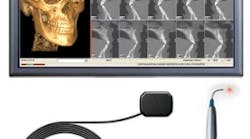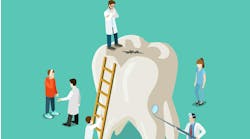Justin Moody, DDS
For more on this topic, go to www.dentaleconomics.com and search using the following key words: dental technology, digital radiography, cone beam imaging, CBCT, CAD/CAM.
Since this is my first time addressing Dental Economics® readers, I wanted to introduce myself and focus on the idea that dentists from small towns can and should be just as current on technology as our big city counterparts.
A few of my practice builders
(Images provided by Biolase, DEXIS, i-CAT)
After attending dental school, I returned to my hometown in western Nebraska to share and then take over the practice of my family dentist. During the transition, I began to think about how technology could really benefit our practice. In 2006, I began by implementing 2-D intraoral digital X-rays (DEXIS®). Adopting this new technology confirmed what I had already suspected. My new digital system not only improved the imaging process but also changed the way we practiced dentistry.
After switching to digital, the comparisons became very clear. Traditional film radiography has many variables. Are the solutions at the right temperature? Are they new enough? Is the film out-of-date? Did I get the exposure times right? AC on the older X-ray units fluctuated. No two PAs looked the same. Since dentists rely heavily on intraoral radiographs, I knew that I needed more to give my patients the best diagnosis. With digital X-ray, the image is clear, sharp, and predictable.
Ten years ago, I started placing implants. Back then, I was taking several film radiographs of the paralleling pin to make sure I had the correct position. The same goes for endodontics, with multiple X-rays during procedures. Digital images are clearer and instantaneous.
In implant dentistry, or in any kind of surgery, reducing the surgical times decreases healing times and lowers the likelihood of having postoperative complications. We don’t want to add a half hour of waiting time to an already complex appointment. Shorter appointment times also let me fit more patients into my daily schedule, which makes good economic sense.
Besides digital 2-D imaging, I also have invested in two different field-of-view 3-D machines (i-CAT® and GXCB-500™ by Gendex). It is becoming apparent that the standard of care is moving toward CBCT imaging for implant placement, and I always want to do what is best for my patients.
I get a true anatomical representation from the 3-D scan, so I know the implant will have adequate bone volume when placed. I explain to my patients that if they are going to spend the money to put in implants, the scan is part of the treatment – not an elective. I have never had anyone say, "I’d rather you just guess."
My in-house orthodontist finds i-CAT 3-D scans an invaluable item in her treatment planning tool kit. Also, if she requests that I uncover an impacted tooth for bracketing, I use the scan to find its exact location.Then I use a laser (ezlase™ by Biolase) to quickly remove the tissue. Long gone are the days of large incisions and long healing times that make procedures difficult for patients.
CAD/CAM has made its way into my practice as well. I incorporated E4D™ and also E4D Dentist™, which allow me to generate restorations in my office, another time-saver for both the patient and me.
While I contribute part of the success of high-tech small-town credibility to having a well-trained team who helps me create value for these services, there is no doubt that the innovations themselves have had a positive financial impact on my practice. That’s good business for small town and big city practices.
Dr. Justin Moody is a diplomate with the American Board of Oral Implantology/Implant Dentistry and the International Congress of Oral Implantologists, and an associate fellow with the American Academy of Implant Dentistry. He also holds mastership and fellow status at the Misch International Implant Institute. He can be reached at [email protected].
Past DE Issues







